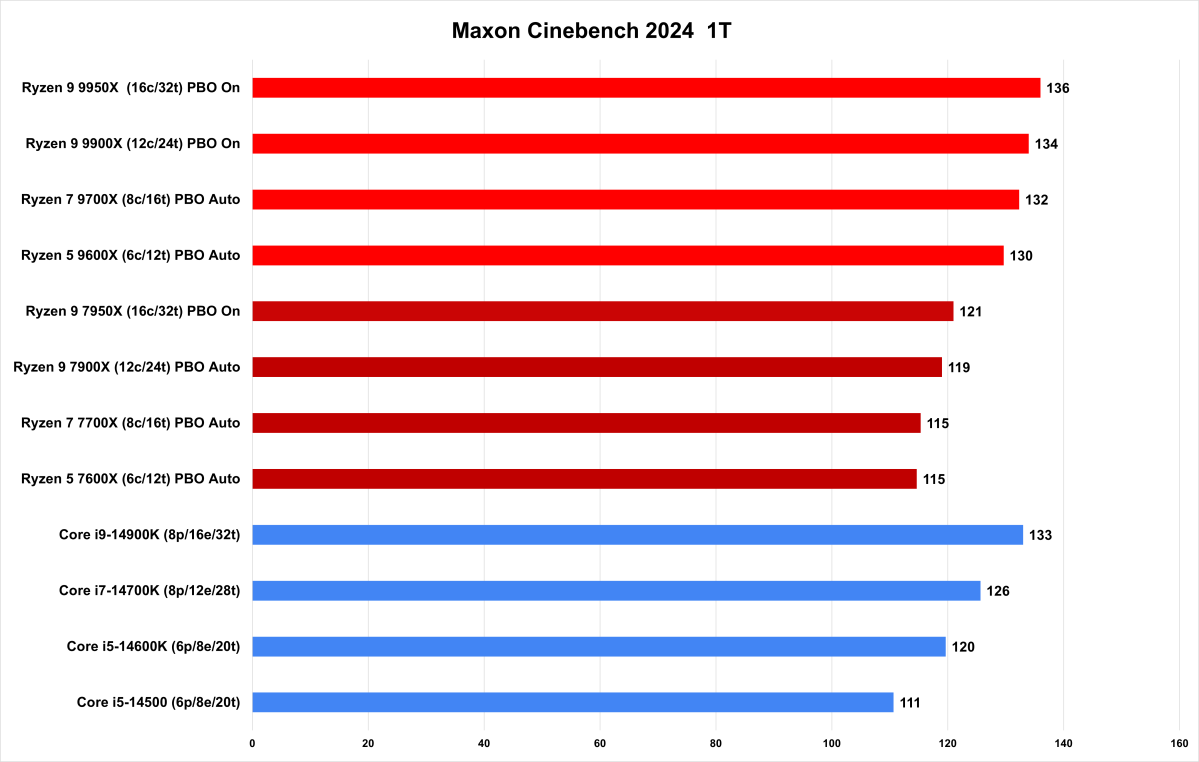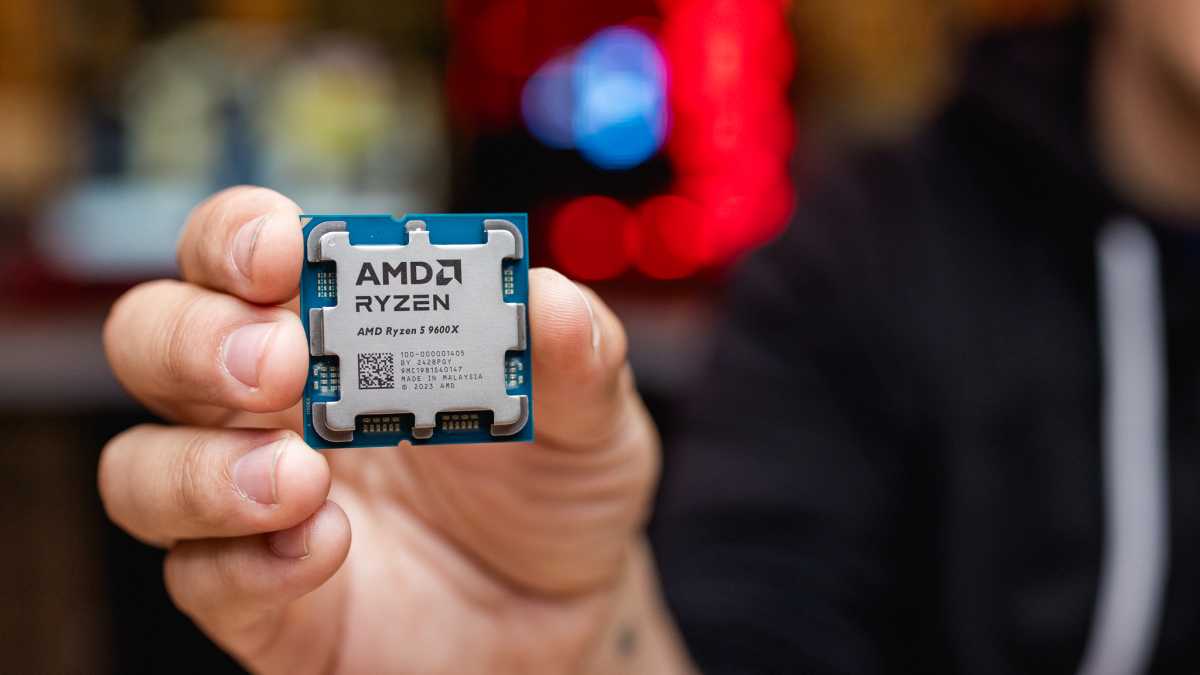[ad_1]
After a temporary delay, AMD’s Ryzen 9000 hit cabinets earlier this month—however to everybody’s shock, the primary processors got here with caveats. Regardless of providing a lot to love, the $279 Ryzen 5 9600X, $359 Ryzen 7 9700X, $499 Ryzen 7 9900X, and $649 Ryzen 9 9950X additionally sported uneven efficiency enhancements.
The explanations for these benchmark outcomes are nuanced, nonetheless. We at PCWorld even delayed the discharge of our deep-dive assessment to raised tease out these fine-grain particulars. (You’ll be able to watch us clarify why on this YouTube video, the place we additionally talk about our preliminary outcomes in-depth.) However in the event you’re questioning if Staff Crimson’s newest silicon is price your money and simply need the short model, listed below are the highest 8 issues it is best to know. For a a lot deeper dive into efficiency, take a look at our full assessment video.
Large enhancements in single-core efficiency
The benchmark numbers for single-core efficiency are related throughout the preliminary lineup of Ryzen 9000 processors—and people outcomes put them on the high. In Cinebench R23, one of many rendering benchmarks we use to place CPUs by way of their paces, the 6-core, 12-thread Ryzen 5 9600X outdid the 7600X by 13 %. Equally, the 8-core, 16-thread Ryzen 7 9700X posted an nearly 15 % enhance over the 7700X.

Adam Patrick Murray / Will Smith / PCWorld
For his or her half, the 12-core, 24-thread Ryzen 9 9900X and 16-core, 32-thread Ryzen 9 9950X provide an nearly 12 % uplift over their Ryzen 7000 predecessors. Total, these positive factors are stable enhancements—and provides AMD a slim edge over Intel.
In opposition to the Core i7-14700K, the 9700X affords a 4.7 % increase in efficiency, and is neck-and-neck with the extra highly effective Core i9-14900K. In the meantime, the 9600X pulls forward of the Core i5-14600K by a little bit over 8 %, which is a pleasant win for customers aware of their budgets. The 9900X and 9950X principally maintain even with the Core i9-14900K—a step up in comparison with Ryzen 7000’s drawback towards Intel’s 14th-gen chips.
However lackluster positive factors in multi-core efficiency
Nonetheless, Ryzen 9000 loses some shine once you have a look at its multi-core efficiency. Benchmark outcomes will be notably affected by motherboard settings—and the best way many reviewers check (together with PCWorld) doesn’t present the silicon’s full vary.
Throughout our preliminary spherical of testing, the 9700X gave basically the identical efficiency because the 7700X in Cinebench R23’s multithreaded check—the skinny 1.48 % doesn’t exceed a standard testing margin of error (normally between 2 to three %).
For Cinebench and Blender, longer bars point out higher efficiency. For Handbrake (which evaluates velocity of check completion), shorter bars are higher.
The result was higher for the 9600X, with a roughly 7 % enhance in Cinebench in comparison with the 7600X, however that uplift is modest in comparison with earlier generational jumps. Usually, 15 to twenty % begins to push the envelope (as seen in single-core efficiency).
This story repeated with related impact in our different rendering and encoding benchmarks used to judge multi-core efficiency. When such minimal positive factors, Ryzen 9000 lags behind Intel’s 14th-gen processors. Choosing a 14700K is a whopping 72 % efficiency enhance in Cinebench over the 9700X, whereas a 14600K is an nearly 60 % increase in comparison with the 9600X. For anybody who wants robust multi-core efficiency (whether or not for intensive work like rendering or simply closely threaded video games), Intel can seem like your higher guess—supplied you’re comfy with the current issues round 14th-gen chip efficiency and longevity.
However staunch Staff Crimson followers shouldn’t despair simply but—as a result of this isn’t the complete story round multi-core efficiency.
Motherboard settings matter
Two settings in your motherboard UEFI (typically nonetheless colloquially known as the BIOS) can vastly affect how properly Ryzen 9000 performs: Precision Increase Overdrive (PBO) and RAM voltage.
Of the 2, PBO performs a higher function in whether or not you’ll see merely meh positive factors, or in the event you’ll get nearer to what AMD guarantees. When enabled, it dynamically feeds extra voltage to the processor for clock velocity will increase—which give higher efficiency.
Not all motherboards allow PBO by default, so in the event you purchase a Ryzen 9000 processor and wish essentially the most out of it, you’ll want to enter UEFI and guarantee it’s on.
Moreover, AMD recommends working RAM at a voltage of 1.2V, slightly than 1.25V (a typical setting). Just like PBO, the latter voltage could be a default on some mobos—like on PCWorld’s personal check {hardware}, a ASRock X670E Taichi.
Altering these settings isn’t tough, however most customers are accustomed to dropping in a chip and transferring on. These obligatory tweaks make Ryzen 9000 really feel finickier than earlier generations, which didn’t want such exact dealing with. Nonetheless, based on AMD, a part of the explanation for this final result is as a result of decrease TDP of the Ryzen 5 and Ryzen 7 processors. With a tighter ceiling on energy effectivity, the stability between efficiency and acceptable working temperature is a finer line to stroll.
AMD’s finest chip can beat Intel’s in multi-core workloads
For Handbrake (which evaluates velocity of check completion), shorter bars are higher. For all different benchmarks, longer bars are higher.
On the extra highly effective (and energy hungry) 9950X and 9900X, the positive factors are a lot bigger when upgrading from their Ryzen 7000 counterparts. The 9950X, which has a 170W TDP, posts an nearly 8.5 % enchancment over the 7950X in Cinebench R23’s multithreaded benchmark.
Enabling PBO for 9950X additionally permits it to outperform Intel’s flagship chip—at the very least in our rendering benchmarks. We noticed a 6.5 % lead in Cinebench R23. The distinction is much more dramatic in different rendering benchmarks, like Blender’s open source exams. The 9950X posted a 30 % enhance within the suite’s Classroom check, a 27 % achieve within the Junkshop check, and a 23 % uplift within the Monster check.
Nonetheless, Intel doesn’t undergo a whole drubbing. In reality, it retains a slight lead in different workloads, like encoding and video manufacturing. Which top-tier CPU is best for you will rely in your commonest (or invaluable) duties.
Spectacular energy effectivity
From a chip nerd’s perspective, AMD’s skill to coax high-end efficiency out of lower-wattage CPUs is unimaginable. The facility effectivity speaks properly of the engineering—Staff Crimson’s first two Ryzen 9000 CPUs have a default TDP of 65W, or almost half of Intel’s base TDP of 125W for the 14700K and 14600K.
In different phrases, AMD’s processors are posting single-core efficiency nearly as good as Intel’s utilizing far much less juice. The weaker multicore efficiency is much less to do with an inherent weak point with the silicon design, and extra to do with how onerous AMD’s prepared to gun the engine for the 9700X and 9600X. We’ve already seen in current CPU generations that a lot of their gigantic efficiency leaps should do with quantity of electrical energy run by way of the chips. In order hinted by the scenario with motherboard PBO settings, that’s the distinction we’re seeing right here.
Stagnant gaming efficiency gen-on-gen (for now)

CD Undertaking Crimson
Nonetheless, the body charges you get are the body charges you get—and in the event you’re a gamer who’s been ready to improve, you’ll wish to really feel that your cash is being invested in a stable bump up.
Reality of the matter is, Ryzen 9000’s gaming efficiency doesn’t transfer the needle a lot previous Ryzen 7000—and in some instances, seems to go backward. You’ll see it most in difficult video games, as evidenced by our Cyberpunk 2077 benchmark outcomes. The small dip within the numbers gen-on-gen can principally be attributed to that commonplace margin of error for testing, as talked about above, however the 9950X really drops by as a lot as 4 %.
Even in video games extra delicate to CPU enhancements, the positive factors are modest, topping out at about 7 % in Tom Clancy’s Rainbow Siege Six and F1 2023. For Whole Warfare: Warhammer III, the largest uplift among the many chips is even smaller, coming in at simply over 4 %.
However whereas that is what you get presently, it might not be what you possibly can count on sooner or later—as steered by a dialog PCWorld just lately had with AMD.
Additional efficiency enhancements might be coming
After two weeks of furor over Ryzen 9000 benchmark outcomes, AMD launched a neighborhood weblog submit addressing the discrepancies between its preliminary gaming-performance guarantees and what reviewers noticed—then dived into the main points throughout a dwell interview with PCWorld.
The important thing cause cited: A distinction in testing parameters, every of which will get coated within the video embedded above. Of word was AMD’s use of an alternate “Tremendous Admin” mode in Home windows for testing, a call meant to mimic coming Home windows department predictor optimizations that assist velocity up processor computations. These updates weren’t accessible to reviewers at launch, and solely simply turned accessible to the general public in a preview model of Home windows 11‘s upcoming annual replace (“24H2”). Different variations in testing that impacted efficiency claims have been VBS safety settings, configurations for comparative Intel methods, and the video games chosen for benchmarking.
The precise enhancements you possibly can count on when the 24H2 replace releases (and afterward, Home windows 10’s equal replace) are onerous to foretell, nonetheless. The video games you play will affect your efficiency positive factors. AMD’s authentic Computex presentation might change into the fact for some Ryzen 9000 homeowners, however these advantages received’t unfold evenly throughout the board.
For the longer term, AMD says it intends to alter its video games testing to incorporate extra real-world outcomes, slightly than specializing in pure isolation of CPU efficiency. That’ll be of profit to everybody watching new chip bulletins; whereas a extra conventional, educational strategy to benchmarking lets chip nerds argue furiously over generational enhancements, us normies will get a greater thought of how CPU upgrades will profit our every day gaming.
Decrease costs than Ryzen 7000

Willis Lai / Foundry
To AMD’s credit score, the corporate is asking for much less cash this time round—so for these watching their budgets like a hawk, a minimal increase in gaming efficiency could not matter as a lot.
The whole lineup sees a discount, with the Ryzen 9 processors dropping by $50 in comparison with final gen, the Ryzen 7 9700X happening by $40, and the Ryzen 5 9600X shaving $20 off the asking worth. (AMD hasn’t confirmed Ryzen 9 costs but however Finest Purchase leaked them.)
- Ryzen 9 9950X – $649
- Ryzen 9 9900X – $499
- Ryzen 7 9700X – $359
- Ryzen 5 9600X – $279
Whereas these costs don’t return to AMD’s extremely inexpensive MSRPs from earlier generations (like Ryzen 3000), they undoubtedly undercut the competitors. At present, Intel’s rival chips have avenue costs of roughly $550 for the 14900K, $380 for the 14700K, and $300 for the 14600K. If you’d like further multicore efficiency, you’ll should pay for it.
[ad_2]
2024-08-23 21:42:00
Source hyperlink:https://www.pcworld.com/article/2422628/amd-ryzen-9000-cpus-8-must-know-details-before-you-buy.html

